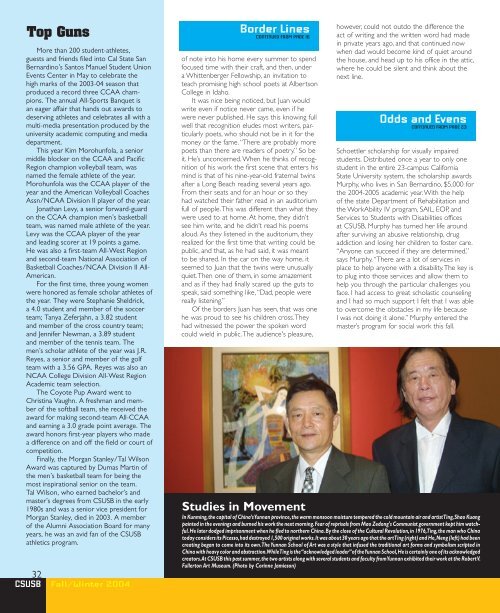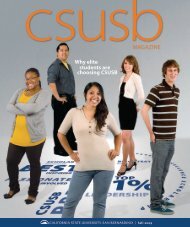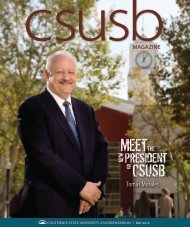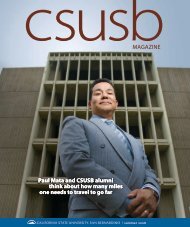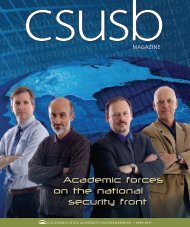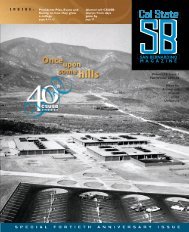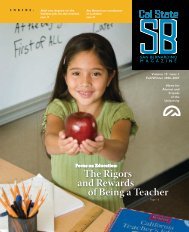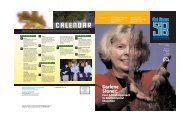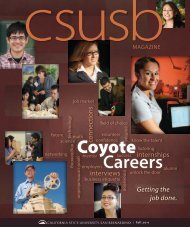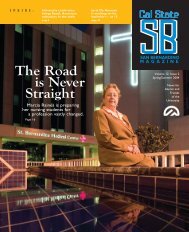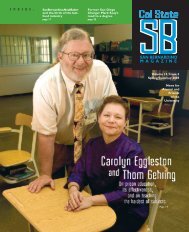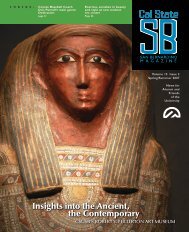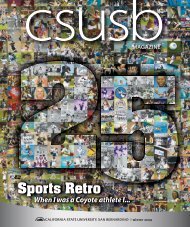04 Fall2.indd - CSUSB Magazine - California State University, San ...
04 Fall2.indd - CSUSB Magazine - California State University, San ...
04 Fall2.indd - CSUSB Magazine - California State University, San ...
You also want an ePaper? Increase the reach of your titles
YUMPU automatically turns print PDFs into web optimized ePapers that Google loves.
Top GunsMore than 200 student-athletes,guests and friends filed into Cal <strong>State</strong> <strong>San</strong>Bernardino’s <strong>San</strong>tos Manuel Student UnionEvents Center in May to celebrate thehigh marks of the 2003-<strong>04</strong> season thatproduced a record three CCAA champions.The annual All-Sports Banquet isan eager affair that hands out awards todeserving athletes and celebrates all with amulti-media presentation produced by theuniversity academic computing and mediadepartment.This year Kim Morohunfola, a seniormiddle blocker on the CCAA and PacificRegion champion volleyball team, wasnamed the female athlete of the year.Morohunfola was the CCAA player of theyear and the American Volleyball CoachesAssn/NCAA Division II player of the year.Jonathan Levy, a senior forward-guardon the CCAA champion men’s basketballteam, was named male athlete of the year.Levy was the CCAA player of the yearand leading scorer at 19 points a game.He was also a first-team All-West Regionand second-team National Association ofBasketball Coaches/NCAA Division II All-American.For the first time, three young womenwere honored as female scholar athletes ofthe year. They were Stephanie Sheldrick,a 4.0 student and member of the soccerteam; Tanya Zeferjahn, a 3.82 studentand member of the cross country team;and Jennifer Newman, a 3.89 studentand member of the tennis team. Themen’s scholar athlete of the year was J.R.Reyes, a senior and member of the golfteam with a 3.56 GPA. Reyes was also anNCAA College Division All-West RegionAcademic team selection.The Coyote Pup Award went toChristina Vaughn. A freshman and memberof the softball team, she received theaward for making second-team All-CCAAand earning a 3.0 grade point average. Theaward honors first-year players who madea difference on and off the field or court ofcompetition.Finally, the Morgan Stanley/Tal WilsonAward was captured by Dumas Martin ofthe men’s basketball team for being themost inspirational senior on the team.Tal Wilson, who earned bachelor’s andmaster’s degrees from <strong>CSUSB</strong> in the early1980s and was a senior vice president forMorgan Stanley, died in 2003. A memberof the Alumni Association Board for manyyears, he was an avid fan of the <strong>CSUSB</strong>athletics program.32<strong>CSUSB</strong>Fall/Winter 20<strong>04</strong>Border LinesCONTINUED FROM PAGE 16of note into his home every summer to spendfocused time with their craft, and then, undera Whittenberger Fellowship, an invitation toteach promising high school poets at AlbertsonCollege in Idaho.It was nice being noticed, but Juan wouldwrite even if notice never came, even if hewere never published. He says this knowing fullwell that recognition eludes most writers, particularlypoets, who should not be in it for themoney or the fame. “There are probably morepoets than there are readers of poetry.” So beit. He’s unconcerned. When he thinks of recognitionof his work the first scene that enters hismind is that of his nine-year-old fraternal twinsafter a Long Beach reading several years ago.From their seats and for an hour or so theyhad watched their father read in an auditoriumfull of people. This was different than what theywere used to at home. At home, they didn’tsee him write, and he didn’t read his poemsaloud. As they listened in the auditorium, theyrealized for the first time that writing could bepublic, and that, as he had said, it was meantto be shared. In the car on the way home, itseemed to Juan that the twins were unusuallyquiet. Then one of them, in some amazementand as if they had finally scared up the guts tospeak, said something like, “Dad, people werereally listening.”Of the borders Juan has seen, that was onehe was proud to see his children cross. Theyhad witnessed the power the spoken wordcould wield in public. The audience's pleasure,however, could not outdo the difference theact of writing and the written word had madein private years ago, and that continued nowwhen dad would become kind of quiet aroundthe house, and head up to his office in the attic,where he could be silent and think about thenext line.Odds and EvensCONTINUED FROM PAGE 23Schoettler scholarship for visually impairedstudents. Distributed once a year to only onestudent in the entire 23-campus <strong>California</strong><strong>State</strong> <strong>University</strong> system, the scholarship awardsMurphy, who lives in <strong>San</strong> Bernardino, $5,000 forthe 20<strong>04</strong>-2005 academic year. With the helpof the state Department of Rehabilitation andthe WorkAbility IV program, SAIL, EOP, andServices to Students with Disabilities officesat <strong>CSUSB</strong>, Murphy has turned her life aroundafter surviving an abusive relationship, drugaddiction and losing her children to foster care.“Anyone can succeed if they are determined,”says Murphy. “There are a lot of services inplace to help anyone with a disability. The key isto plug into those services and allow them tohelp you through the particular challenges youface. I had access to great scholastic counselingand I had so much support I felt that I was ableto overcome the obstacles in my life becauseI was not doing it alone.” Murphy entered themaster’s program for social work this fall.Studies in MovementIn Kunming, the capital of China’s Yunnan province, the warm monsoon moisture tempered the cold mountain air and artist Ting, Shao Kuangpainted in the evenings and burned his work the next morning. Fear of reprisals from Mao Zedong's Communist government kept him watchful.He later dodged imprisonment when he fled to northern China. By the close of the Cultural Revolution, in 1976, Ting, the man who Chinatoday considers its Picasso, had destroyed 1,500 original works. It was about 30 years ago that the art Ting (right) and He, Neng (left) had beencreating began to come into its own. The Yunnan School of Art was a style that infused the traditional art forms and symbolism scripted inChina with heavy color and abstraction. While Ting is the “acknowledged leader” of the Yunnan School, He is certainly one of its acknowledgedcreators. At <strong>CSUSB</strong> this past summer, the two artists along with several students and faculty from Yunnan exhibited their work at the Robert V.Fullerton Art Museum. (Photo by Corinne Jamieson)


